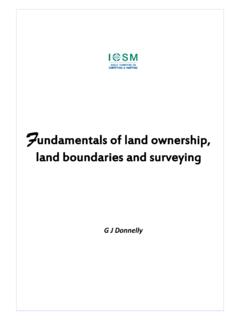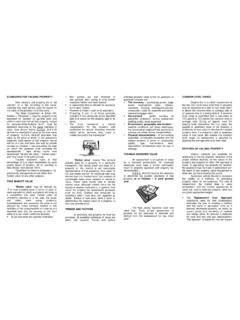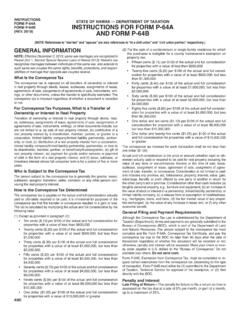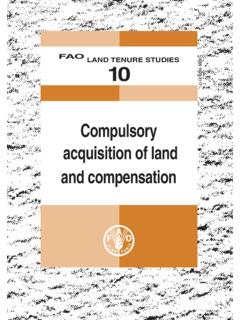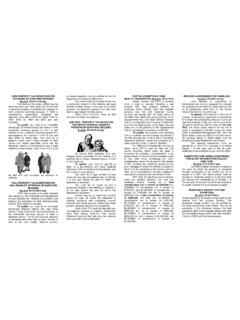Transcription of Land Land Use and Management - environment.gov.scot
1 November 2011 Page 1 land use and Management Scotland's land is primarily rural and is used for a range of agricultural, forestry, sporting and recreational activities. Summary land use in Scotland is diverse and has a strong relationship with the intrinsic properties of the land . Agriculture is the predominant land use in Scotland, covering around 70% of the land area. Woodland currently covers around 18% of Scotland, most of which is coniferous plantation. Large areas are used primarily for sporting activities (deer and grouse). Only about of the country is urban and much of this is in the Central Belt. There is an increasing awareness that sustainable Management of our land , across all sectors, has a key role in our response to climate change. Introduction The way land is used and managed helps shape our landscape. The types and pattern of land use in Scotland have developed over many hundreds of years to what we see today.
2 land use has changed in response to factors such as population growth, industrialisation and improved transport links and infrastructure. In the past, Scotland had a much greater (entirely native) woodland cover. Much of this was removed over a prolonged period as a result of agricultural improvements, timber extraction, burning, grazing and climate change. November 2011 Page 2 Virtually all of Scotland's land is rural in nature, with only approximately classified as urban. This includes our towns and cities, our transport network and infrastructure and our industrial and retail sites. The remainder rural land comprises large areas of different types of semi-natural vegetation ( heather moorland and blanket bog); grasslands and woodlands; and fields of cereal crops and vegetables. Scotland's land contributes in a number of ways to Scotland's environmental, economic and social well-being. It provides a range of benefits including food, timber, energy and recreational opportunities.
3 It also provides the buffer between our fresh water resources and pollutants, which may otherwise damage water quality. It contains an enormous stock of above and below ground carbon. Indeed, with respect to the emission of greenhouse gases, land use is the only sector that both emits greenhouse gases to and removes them from the atmosphere. The multiple benefits provided by land are recognised in the Scottish Government's land Use Strategy. There are a number of ways to assess the contribution of Scotland's land to our economy. A recent study argued that one in seven Scottish jobs depends to some extent on the land , providing over 17 billion to the Scottish economy. This demonstrates the value of the natural resource base to the economy of rural Scotland. Agriculture and forestry make important contributions to the Scottish Economy. Sporting activities also make a substantial contribution in locations where other sources of income are scarce.
4 Deer Management is estimated to contribute over 100 million annually to the Scottish economy. As well as our primary industries employing people directly, the food and drink industries which rely on those primary products ( cattle, sheep and grain) employ around 360,000 people. The direct exploitation of Scotland's land resources through mining and aggregate extraction is estimated to be worth 550 million per year. Scotland's land is increasingly being recognised for its value in enhancing the nation's health. Activities such as walking, climbing, biking, horse riding and golf are all known to have physical and mental health benefits. They also generate substantial economic activity and income, and Scotland is actively marketing itself as an international centre for these forms of outdoor activity. Soil also supports the greenspace within our towns and cities where a large proportion of our outdoor recreation takes place.
5 November 2011 Page 3 Description of land use and Management Scotland's land is used for a variety of activities, with some areas used for more than one, for example for rough grazing of domestic livestock and for sporting Management and related activities. For this reason there is no unambiguous statistic that pigeonholes each area of land into a single use. State and trend Agriculture is the most dominant single use of land the most recent estimate from the Scottish 2011 June Agricultural Census is that it covers million ha (approximately 70% of Scotland). However, within this figure, it must be recognised that almost 8% is woodland and is classified as 'other land '. Nevertheless, it can be safely concluded that agriculture is the most extensive land use in Scotland. The area of agricultural land (excluding common grazings) in Scotland has declined from million ha in 1982 to million ha in 2011. Woodland and urban expansion are likely to be the main reasons for this.
6 There have also been changes in land use within the agricultural area. For example, the area under arable Management has declined by about 13% and rough grazing by around 21% (or about 800,000 ha), whereas permanent (sown) pasture has increased since 1982. Care should be taken in the strict interpretation of these figures due to changes in definition and methods of reporting. Within the arable sector, there has been a large increase in the area of wheat and a decline in spring and winter barley since 1982, nevertheless spring barley remains Scotland's principle arable crop. Oilseed rape was virtually unknown in 1982 in Scotland, but grew to a maximum sown area of 70,000 ha in 1994; however, this dropped back to just over half this figure by 2010. The area of potatoes has remained relatively stable. Until the mid-1950s, oats was the predominant cereal in Scotland, occupying around 75% of the arable land . November 2011 Page 4 The introduction of autumn-sown crops such as winter wheat, changes in dietary preferences and responses to market signals are responsible for these changes (Figure 1).
7 It should be noted that arable crops, particularly barley, are often grown in rotation with grass; this feature is more prevalent in Scotland than other parts of the UK. Figure 1: Changes in cropping areas from 1938 to 2008 Source: Changing land Use in Rural Scotland - Drivers and Decision-Making: Rural land Use Study Project 1 (Report) Scotland is famed for the quality of its livestock production, and their production and Management covers a much larger proportion of Scotland than arable and horticultural land . Grazing also has a profound effect on the appearance of our landscape. Cattle numbers have fallen by around 500,000 to million between 1982 and the present day. Much of this decline is due to the 40% decline in numbers of dairy cattle to around 270,000, although production has not necessarily fallen by a similar amount due to factors such as cattle weight increasing and feeding regimes. The most significant change has been in sheep numbers, which have fallen from almost 10 million in 1992 to just under 7 million in 2011.
8 Longer-term trends are shown in Figure 2. Figure 2: Changes in livestock numbers from 1938 to 2008 November 2011 Page 5 Source: Changing land Use in Rural Scotland - Drivers and Decision-Making: Rural land Use Study Project 1 (Report) The Abstract of Scottish Agricultural Statistics 1982 2011 provides further information on the June agricultural census data for those years. Woodland currently covers 1,385,000 ha of land , approximately 18% of Scotland. This is almost half of all woodland in the UK. Seventy-eight per cent of Scotland's woodland is coniferous, the majority of which is fast growing non-native species such as Sitka Spruce or Lodgepole Pine (combined covering 650,000 ha). The remaining 22 % is made up of broadleaves. A survey is currently being undertaken to identify the location and types of all native woodlands in Scotland. There was a large increase in new woodlands in Scotland from the end of the Second World War when woodland cover was until the late 1980s.
9 Planting rates of new woodland peaked in the 1970s at over 30,000 ha per year, steadily dropped back to around 3000 ha in 2009 10, but increased to 5100 ha in 2010 11. The large decline since the 1980s is primarily due to changes in taxation rules for private investors. The Scottish Forestry Strategy has a target of 25% woodland cover in Scotland by 2050. The Scottish Government's rationale for woodland expansion suggests an increase in woodland area of about 650,000 ha. Large areas of land classified as agricultural rough grazing are likely to have deer and/or grouse Management as the principal land use. When combined with land that is not used for agriculture, it is probable that at least 20% (around million ha) of Scotland's land area is managed primarily for sporting purposes. The total number of deer in Scotland is not known, although various estimates over the last 10 years vary from 350,000 to 600,000. This excludes any impact from the harsh winters of 2010 and 2011.
10 Large areas of Scotland are protected under a range of designations, many of which overlap. Some of these designations focus on nature conservation (such as Sites of Special Scientific Interest (SSSI)), while others are concerned with special landscapes (such as National Scenic Areas). The Management of multi-functional protected areas (such as our National Parks) seeks to balance the needs of people, landscape and nature. The first recognition of the value of Scotland's natural assets was the identification of the first National Nature Reserve at Beinn Eighe in Wester Ross in 1951. Now we have 1447 SSSIs covering of Scotland and, although the European Directive Special Protection Areas (SPA) and Special Areas of Conservation (SAC) designations cover similar sized areas, there is substantial overlap between all three. Designation does not preclude land uses such as those described above indeed many have woodland and sporting interests but through Management agreements, they do put conditions on the type of activity permitted on them.




